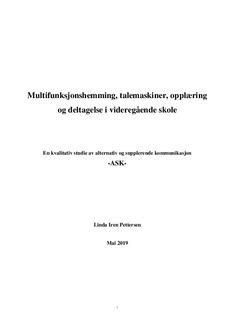| dc.contributor.advisor | Heidi Gilstad | |
| dc.contributor.author | Linda Iren Pettersen | |
| dc.date.accessioned | 2019-09-19T14:01:35Z | |
| dc.date.available | 2019-09-19T14:01:35Z | |
| dc.date.issued | 2019 | |
| dc.identifier.uri | http://hdl.handle.net/11250/2617789 | |
| dc.description.abstract | «Multifunksjonshemming, talemaskiner, opplæring og deltagelse i videregående skole»
I takt med den teknologiske utviklingen får stadig flere med delvis eller fullstendig bortfall av talespråk tilgang til talemaskin. Fra eget arbeid i PP- tjenesten har jeg erfaring med å delta i de innledende vurderingene som finner sted knyttet til valg av kommunikasjonshjelpemidler for multifunksjonshemmede elever i videregående skole. Når talemaskin vurderes som egnet kommunikasjonshjelpemiddel for en multifunksjonshemmet elev, er dette ofte knyttet til argumenter om at talemaskinen vil bidra positivt til elevens mulighet til deltagelse og medvirkning i eget liv og samfunn.
Prosjektets formål er å bidra med ny kunnskap til praksisfeltet alternativ og supplerende kommunikasjon (ASK) med et særlig fokus på multifunksjonshemmede i videregående skole og opplæring i bruk av talemaskiner. I prosjektet undersøker jeg også ulike aspekter knyttet til begrepet deltagelse i sammenheng med talemaskiner, multifunksjonshemming og opplæring.
Dataene i prosjektet genereres ved at jeg benytter meg av to ulike kvalitative metoder; strukturert observasjon i klasserom og semistrukturert intervju med kontaktlærer. I arbeidet med å analysere dataene fra observasjon og intervju benytter jeg en såkalt stegvis – deduktiv – induktiv metode (SDI). I SDI – metoden arbeider forskeren i etapper fra rådata til konsepter eller teorier, fra empiri mot teori.
Resultatene fra studien viser at deltagelse som følge av talemaskinbruk og opplæring forutsetter spesifikk og digital ASK- språklig kompetanse både hos multifunksjonshemmede ASK- brukere og hos deres kommunikasjonspartnere. Å utvikle spesifikk talemaskinkompetanse er tid- og energikrevende. Det er i tillegg også avhengig av et omfattende samarbeid mellom flere og ulike skoleinterne og skoleeksterne instanser. I hvilken grad multifunksjonshemmede elever har tilgang på talemaskiner som del av sin ASK – språklige opplæring er også avhengig av i hvilken grad talemaskinutviklere og opplæringsansvarlige evner å legge til rette med tekniske funksjoner og opplæringsmetoder som gjør det mulig for elever med store motoriske, sensoriske og kognitive utfordringer å få tilgang til og å velge innhold på talemaskinene. Til slutt er det også slik at talemaskiners eventuelle bidrag til økt grad av deltagelse for multifunksjonshemmede elever synes å være avhengig av at elevenes kommunikasjonspartnere også har god kjennskap til elevenes øvrige og ulike ASK- uttrykk. | |
| dc.description.abstract | A study of speech generating devices and education for upper secondary students with profound and multiple learning disabilities.
As technology progresses, an increasing number of people with partial or complete loss of voice language gain access to speech generating devices. From my own work in the Norwegian PP service, I have experience in participating in the initial meetings and assessments that take place in connection with the selection of communication aids for students with profound and multiple learning disabilities in upper secondary school. Arguments used in intimal meetings tend to advocate that the voice machine will contribute positively to the student’s ability to participate and influence their own life and community.
The purpose of the study is to contribute with new knowledge to the field of alternative and augmentative communication (AAC). Specifically my study investigates the various aspects of participation in relation to speech generating devices used by students with profound and multiple learning disabilities and on site upper secondary training and education.
For data generation I have made use of two distinctive qualitative methods; classroom observation and an interview with the students` main teacher. When analyzing the data I used the stepwise - deductive - inductive method (SDI). In the SDI method, the researcher works in stages from raw and empirical data towards concepts or theories.
The results of the study show that participation as a result of voice machine use and training presupposes specific and digital AAC language and communication competence among AAC users and with their communication partners. Developing specific voice machine skills is time-consuming and energy-intensive. In addition, developing these skills is dependent on a comprehensive collaboration between several and different internal and external school bodies. Multifunctional students` access to voice machines as part of their AAC language and communication training is also dependent on the extent to which both manufacturers of voice machines and teachers are able to facilitate training and technical solutions that enable students with major motor, sensory and cognitive challenges to access and select meaningful content on their voice machines. In conclusion, successful use of voice machines as part of AAC language and communication for students with profound and multiple learning disabilities seems dependent on the pupils' communication partners having extensive knowledge of all the student's different AAC expressions. | |
| dc.language | nob | |
| dc.publisher | NTNU | |
| dc.title | Multifunksjonshemming, talemaskiner, opplæring og deltagelse i videregående skole. En kvalitativ studie av alternativ og supplerende kommunikasjon. | |
| dc.type | Master thesis | |
